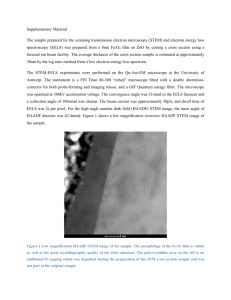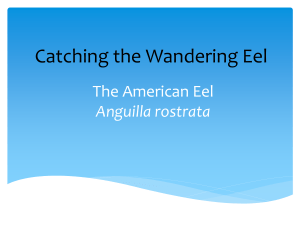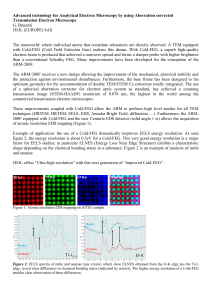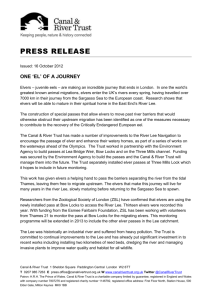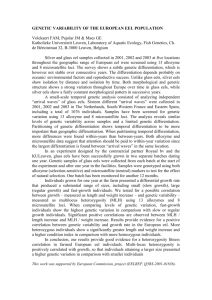Translation
advertisement
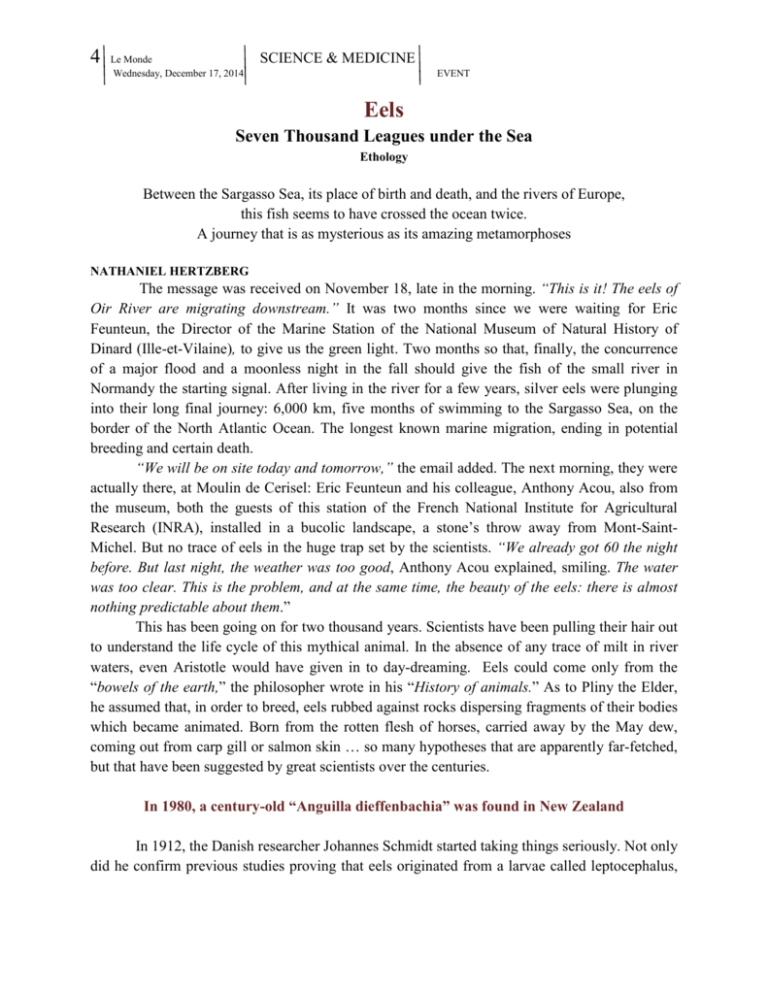
4 Le Monde Wednesday, December 17, 2014 SCIENCE & MEDICINE EVENT Eels Seven Thousand Leagues under the Sea Ethology Between the Sargasso Sea, its place of birth and death, and the rivers of Europe, this fish seems to have crossed the ocean twice. A journey that is as mysterious as its amazing metamorphoses NATHANIEL HERTZBERG The message was received on November 18, late in the morning. “This is it! The eels of Oir River are migrating downstream.” It was two months since we were waiting for Eric Feunteun, the Director of the Marine Station of the National Museum of Natural History of Dinard (Ille-et-Vilaine), to give us the green light. Two months so that, finally, the concurrence of a major flood and a moonless night in the fall should give the fish of the small river in Normandy the starting signal. After living in the river for a few years, silver eels were plunging into their long final journey: 6,000 km, five months of swimming to the Sargasso Sea, on the border of the North Atlantic Ocean. The longest known marine migration, ending in potential breeding and certain death. “We will be on site today and tomorrow,” the email added. The next morning, they were actually there, at Moulin de Cerisel: Eric Feunteun and his colleague, Anthony Acou, also from the museum, both the guests of this station of the French National Institute for Agricultural Research (INRA), installed in a bucolic landscape, a stone’s throw away from Mont-SaintMichel. But no trace of eels in the huge trap set by the scientists. “We already got 60 the night before. But last night, the weather was too good, Anthony Acou explained, smiling. The water was too clear. This is the problem, and at the same time, the beauty of the eels: there is almost nothing predictable about them.” This has been going on for two thousand years. Scientists have been pulling their hair out to understand the life cycle of this mythical animal. In the absence of any trace of milt in river waters, even Aristotle would have given in to day-dreaming. Eels could come only from the “bowels of the earth,” the philosopher wrote in his “History of animals.” As to Pliny the Elder, he assumed that, in order to breed, eels rubbed against rocks dispersing fragments of their bodies which became animated. Born from the rotten flesh of horses, carried away by the May dew, coming out from carp gill or salmon skin … so many hypotheses that are apparently far-fetched, but that have been suggested by great scientists over the centuries. In 1980, a century-old “Anguilla dieffenbachia” was found in New Zealand In 1912, the Danish researcher Johannes Schmidt started taking things seriously. Not only did he confirm previous studies proving that eels originated from a larvae called leptocephalus, 4 Le Monde Wednesday, December 17, 2014 SCIENCE & MEDICINE EVENT but at the end of four successive campaigns, he delimitated their spawning area: the Sargasso Sea, in the tropical area of the North Atlantic. The biologist’s discovery left many questions unanswered. How do these tiny creatures manage to cross the Atlantic to reach our shores? How do they choose the rivers where they settle, generation after generation? What is the process of the three metamorphoses completed throughout their life cycle? Why do they decide to leave one day and how do they find their spawning area again? If, in one century, some of these mysteries have been solved, “today we still have many more questions than answers,” Eric Feunteun emphasizes. Elsa Amilhat, his colleague from the University of Perpignan, also adds: “With everything that science has managed to solve, it is unbelievable to what extent this animal remains mysterious.” So, at the beginning, a larva. A transparent flat body, a few millimeters long. A small elongated head, large eyes and long teeth. “More like a willow leaf than a fish,” as described by Eric Feunteun. Coming out in millions from each egg-laying fish, these apparently inert creatures already display complex behavior. At night, they let themselves be carried away by the current at a depth of about 25 meters. During the day, they go down to 200 meters, to the “oceanic desert.” Little light, no plankton. And yet, they feed themselves. According to recent measurements made with nitrogen and carbon isotopes, they consume marine snow, dead matter agglomerate on which microorganisms grow. “The leptocephalus assimilates what nobody wants, Eric Feunteun insists. From the very beginning, eels settle in habitats that no other creatures occupy. And they go on like this all their lives.” But for the moment, the eels have to keep going. Certainly, there is the powerful Gulf Stream, a real highway to Europe and the larvae will let it carry them for two to three years. At least, this is what oceanographic models applied to an inert particle showed for years. Except that leptocephali swim. In 2009, the Canadians showed that, under the best conditions, the larvae could complete their migration in just over a year. This brings us closer to the results of the otolith analyses. Located in the ear of fish, these small concretions bear the traces of time, just like tree trunks. Since 1990, the University of Pau has been the world champion in the microscopic examination of striations less than 1 micron thick, reaching a rate of one a day … almost. Or between the first feeding, ten days after hatching, and the first metamorphosis, just before reaching the European shores, a total number of 200 to 300 striations have been found. So less than one year of migration? Two to three years? The controversy continues, supported by new articles every year. “And it is unlikely to be quickly resolved,” concluded a summary article published in the Journal of Biology in 2012. The shore is getting closer, the leptocephalus has grown, measuring 8 cm. It stops feeding. It loses 25% of its weight and one eighth of its length. Its primary teeth fall, being replaced by permanent teeth. The body becomes refined, turning the “leaf” to a “stem.” The skin, translucent until then, becomes pigmented. The animal is ready for its elver life. It is at this stage that eels are most prized by fishermen, restaurant owners and other aquaculture farms. As for elvers, they have two priorities: to wait for the right tide and to find the river, their river. How do they choose? Undoubtedly, using their incredible sense of smell. Laboratory 4 Le Monde Wednesday, December 17, 2014 SCIENCE & MEDICINE EVENT studies have shown that elvers trace elements with an infinitesimal concentration, of the same order as the one detected by forensic science. Traces left by the passage of their elders have opened their way. Our “experts” can now rush to streams and rivers. [Photo caption:] When leaving the Sargasso Sea, the leptocephalus larva is 7 mm long. PAOLO DE OLIVEIRA/NHPA/BIOPHOTO Little by little, elvers grow, their skin thickens. Eighty kilometers upstream, they have already become eels. At the end of their migration, they will become yellow eels. Nothing seems to discourage them. Clear or brackish waters, swamps, ponds or springs, from Lapland to Morocco for the European eel, and on four other continents for its sixteen cousin species, an eel adapts to anything. An obstacle in its way? It comes out of the water, avoids it by crawling or even climbing over it. Back from his mission in Vanuatu, in the Pacific Ocean, Anthony Acou’s eyes are still sparkling as he describes the achievements of the Anguilla megastoma: “It climbs up waterfalls and during its downstream migration, it goes back down tail first.” Meanwhile, it will have “chosen” a sex. Indeed, the determination takes place around the age of 3. “We know the hormonal mechanism that guides this choice and the importance of environmental factors, explains Sylvie Dufour, biologist at CNRS (National Institute for Scientific Research) and Head of the Boréa Research Unit in Paris. Density, salinity, temperature, stress… But the impact of each of these factors has yet to be demonstrated.” Observing their distribution, we can see that saline waters, close to estuaries and a high population density, favor males. Conversely, females are pioneers and go further upstream. “As if the species had understood that, if they find a hostile environment it’s better to return to the sea as soon as possible, in order to pass on the genes, explains Eric Feunteun. Or males reach maturity faster, migrating downstream earlier. On the contrary, in a more favorable environment, an eel can take the “risk” of being a female and stay in the river longer, because if it reaches its spawning area, it is sure that its genetic heritage will be passed on in the form of eggs.” How long do they live like that, waiting for the great departure? Two to … one hundred years, depending on the sex, species and latitude. In 1980, a century-old Anguilla dieffenbachia was found in New Zealand. In Europe, eels over 40 years old have been regularly observed in the Irish lakes. On November 19, Anthony Acou examined the ten specimens that he had kept for us from the day before. The largest eel measured 76 cm and weighted 950 grams. Using a gun, he introduced a magnetic tag that would allow for monitoring its evolution in the river. The next eel was smaller, the scale showing 57.5 cm and 459 grams. But it had overall completed its last metamorphosis: the silvering. Its eyes had quadrupled in size, its pectoral fin had developed and its skin had thickened. A very distinctive line separated its black back from its white silvery abdomen. This time, no animal badge was needed: captured and tagged in 2002, it had been found again twice during scientific fishing, a few kilometers upstream from the mill. Based on calculations, Anthony Acou estimated that it was 21 years old. “An old little beast,” he says. 4 Le Monde Wednesday, December 17, 2014 SCIENCE & MEDICINE EVENT An adolescent, still, that would complete its puberty during the most mysterious part of its life: the return to the spawning area. What we know is already amazing. During the silvering stage, the eel’s anus closes and the eel completes its great journey without feeding. How? Thanks to an extremely economical mechanism. The oxygen consumption studies conducted in a swimming tunnel concluded that no other fish could even come near its frugality. Tags also allowed for establishing its swimming profile. Trying to avoid light and predators, our marathon runner spends its days at a depth of 600 meters, sometimes even deeper, facing cold temperatures and especially pressures that few living beings can withstand. But every night it climbs back up 300 meters, towards warmer waters. An alternation that allows silver eels to reach their spawning area at their sexual maturity. Neither sooner, nor later. However, this is where knowledge stops and speculations begin. How do eels find directions? Do they follow currents, a salinity front or a magnetic “compass”? Do they use light and their high-performance eye that allows them to distinguish a sunbeam in places where others remain plunged in the dark? Do they take advantage of a memory recorded on their coming route that allows them to find their way back? Just as many questions which the European Eeliad Project (from the English “eel”), launched in 2009, hoped it could answer, by equipping 120 eels with Argos tags. Very ambitious, but financially burdensome (each tag costs 3,000 Euro), the device presented a risk: could our brave travelers withstand the 30 additional grams in their backpack? An obstacle in its way? It comes out of the water, avoids it by crawling or even climbing over it Since no tag reached the Sargasso Sea, these questions are still unanswered today. Swedish fish went around Scotland before plunging towards South, like the Irish and the French ones. But they all tripped on the Azores, if they didn’t die sooner. Scientists obtained key information on the swimming profiles of eels and … pilot whales, these humpback dolphins which, as we discovered in the process, were crazy about anguillidae (fresh water eels). However, the end of the route remains unknown. In 2013, Elsa Amilhat and her colleagues from Perpignan recreated this experiment by using eight specimens from the South of France. For the first time, they proved that eels from the Mediterranean passed the Gibraltar and started their journey into the Atlantic. But they didn’t reach the Azores. Then, where do the European eels go? To the Sargasso Sea, as stated by Johannes Schmidt? Without a doubt. Again, in 2013, a German team found European larvae in the mythical sea. Still, no trace of egg-laying fish. Actually, out of the 17 species of eels, only one has revealed its secrets. After eighteen years of research and eleven campaigns, in 2009, Professor Katsumi Tsukamoto, a biologist at the University of Tokyo (Japan) found Japanese eel eggs and nineteen adults near the Mariana Islands in the Pacific Ocean. 4 Le Monde Wednesday, December 17, 2014 SCIENCE & MEDICINE EVENT Eric Feunteun dreams of emulating his Japanese mentor and proving the great Schmidt wrong. Chemical analyses of the otoliths of European eels have indeed indicated the presence of manganese. “This is a volcanic element. Or, there is no such thing in the Sargasso Sea,” the biologist said enthusiastically. And what if the “good” eggs, those whose fish manage to end up on our shores, hatched 2,000 km further east, above the reliefs of the Mid-Atlantic Ridge? “That would make everyone agree, confirming both models and analyses, he continues. There is only one thing missing: the eels.” A snag that Eric Feunteun is hoping to easily remove. He has just submitted a funding request for a sea campaign to be carried out in 2018. A “Prehistoric” Animal From the Dinosaur Age up to the present. This is the other journey completed by the eel. For most scientists, the family was born at the end of Cretaceous period, about 70 million years ago and it has practically not evolved since. A fossil found in the Middle East seems to prove this. Genetic analyses conducted on mitochondrial DNA allowed for retracing its route. The works conducted on the entire genome by Thierry Wirth of the National Museum of Natural History, led him to believe that eels appeared 30 million years ago, rather. But he found more or less the same expansion. Eels, which first appeared near the Indonesian shore, over millennia reached Japan to the North, and Oceania to the South, Africa and finally Europe to the West. At the time, a wide passage (Tethys) connected Asia to the Atlantic directly. The Atlantic Ocean, which appeared 65 million years ago, was just a small ocean at the time and the route between the sea and the river was nothing but a gentle ride. Since then, the ocean has continued to get bigger, so the walker has become a marathon runner. [Photo captions:] Fishing for elvers on the Loire River. ERWAN BALANÇA/BIOSPHOTO An elver measures 70 mm upon its arrival on the European shores. PHILIPPE GARGUIL/BIOSPHOTO In the yellow eel stage, the fish goes upstream on European rivers. ERIC FEUNTEUN During its downstream migration, eels are silvery. They are ready to restart their journey towards the Sargasso Sea, their spawning area. HUGO WILLOCX/BIOSPHOTO FILE ONE Formerly a Harmful fish, now under protection 4 Le Monde Wednesday, December 17, 2014 SCIENCE & MEDICINE EVENT An eel is a bundle of paradoxes. Let’s see for ourselves. Until 1984, this animal was classified as harmful. In our rivers, noble salmons disappeared while eels proliferated. The culprit was identified, and those who would accidentally fish it were not allowed to throw it back into the water. That was the time when elver lines, several kilometers long, were filling up the shores, while fish slipped between the children’s fingers in French rivers. Then the biologists got it: salmons were dying because of pollution. For a while, eels had took advantage of the free space left, before their own decline started. Draining of swamps, increased numbers of dams, intensive fishing, and PCBs and other toxic materials finally prevailed over this animal’s robustness. In 1999, European experts declared that the population was endangered, and in 2007, the Parliament of Strasbourg imposed a strict management plan. Over twenty years, the monitoring of downstream migrations recorded an 80% decrease in the volume of caught fish, while prices exploded. The Convention on International Trade in Endangered Species of Wild Fauna and Flora (CITES) held in Washington in 2010, prohibited the export of European elvers outside the continent. The fishing tsunami Installation of fish ladders on barriers, imposition of quotas accompanied by the obligation to allocate 60% of elver fishery outputs to repopulating rivers and to decrease the yellow- and silver-eel catches by 30%. “These measures caused a real fishing tsunami, says Philippe Boisneau, chairman of the eel fishermen’s association of the Loire River. Between 2009 and 2014, 200 freshwater and 600 marine fishermen disappeared from the statistics, because the price of elvers went from 800 euros per kilogram to 150 or even 50 euros at the end of the season. We observed the rules and met the objectives. But we were the only ones.” The fishermen’s leader points the finger at the dams, the chemical industry, and at amateur fishermen that are not regulated. Except that, for last three years, the plan seems to have shown its first results. As for the elvers, it’s clear. In areas where fishermen needed a month and a half to reach their quota, this year, in the Adour Basin, they exceeded it in four nights. A significant increase in elvers was also found in the observation ladders. The fishing quotas were then increased slightly. “Pay attention, warns biologist Eric Feunteun, ten years ago, some predicted that the species would be extinct in 2020. Today, the same ones are crying out victory. I’m not sure that they are more clear-sighted now.” In his opinion, the improvement could be due to the change in the North Atlantic oscillation index, caused by the approach of temperatures between the North Pole and the Tropic of Cancer, which would push the larvae into the right direction. The latest trick played by the eel. N.H. FILE TWO 4 Le Monde Wednesday, December 17, 2014 SCIENCE & MEDICINE EVENT Controlling Captive Breeding Katsumi Tsukamoto is an icon in Japan. At 66, this biologist of the Tokyo University has received countless honors. World expert in eels, he is the first and, so far, the only scientist to have formally identified the spawning area of one of the 17 species existing on the planet, Anguilla japanica. First and maybe foremost, he has become the master of breeding. In the Archipelago, there is a lot at stake. The eel is a sort of emblem, present in mythology. Most importantly, it is a delicacy. For decades, Japanese food giants have been importing elvers coming from Europe, which they grow in aquaculture. In their labs, they are pursuing a dream: to control the entire cycle. It is for one of these companies, the Irago Institute of the Toya Suisan Group, that Katsumi Tsukamoto first managed to transform the leptocephalus larvae into elvers in 2003. “Up until then, we were faced with two obstacles: the quality of the eggs and the feeding of the larvae, he explains. By using adapted hormones on the breeders, we have managed to improve the larvae. Today, about 1% of the eggs become robust leptocephali. As each female lays several million eggs, it is fine.” The food challenge The more complicated aspect was the feeding of leptocephali. Rotifers (a particular type of plankton) with algae extracts, jellyfish with oyster eggs, “and many other things,” we tried everything. “Finally, we found shark eggs, to which we added soy peptides and Antarctic krill extracts,” says the biologist. The winning cocktail has been improved since. In 2015, we should see the fourth generation of captive eels being born. “But it was a French man who took the first step,” the scientist says. In 1964, Maurice Fontaine managed, in a lab of the Museum of Natural History, to determine an embryonic development in captivity. His recipe: the urine of a pregnant woman and extracts of carp pituitary gland. But things have stagnated in Europe since then. The larvae never lived for more than a few days. The latest program, coordinated by Denmark, has, once again, been faced with the food problem. “We have made progress, we are producing several dozen larvae per female, emphasizes Sylvie Dufour, former student of Maurice Fontaine, currently Research Director at CNRS and director of the Boréa lab. But they will not eat.” “The sexual maturation of the European eel is much slower, therefore, more difficult, states professor Tsukamoto, in all fairness. It is your problem.” His problem nowadays is to lower the costs of eels born in captivity. You have to consider 100 dollars per animal, he says. Compared to 1 dollar for those coming from catching elvers.” “The journey is long,” he smiles. N.H.


